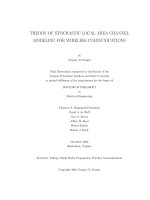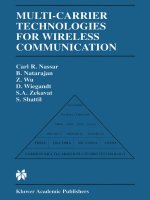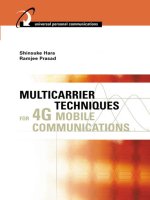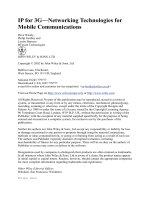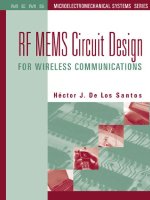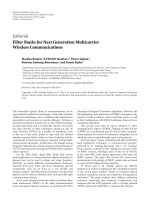Multi-Carrier Technologies for Wireless Communication
Bạn đang xem bản rút gọn của tài liệu. Xem và tải ngay bản đầy đủ của tài liệu tại đây (4.69 MB, 215 trang )
MULTI-CARRIER TECHNOLOGIES
FOR WIRELESS COMMUNICATION
This page intentionally left blank
MULTI-CARRIER TECHNOLOGIES
FOR WIRELESS COMMUNICATION
by
Carl R. Nassar, B. Natarajan, Z. Wu
D. Wiegandt, S. A. Zekavat
Colorado State University
S. Shattil
Idris Communications
KLUWER ACADEMIC PUBLISHERS
NEW YORK, BOSTON, DORDRECHT, LONDON, MOSCOW
eBook ISBN: 0-306-47308-9
Print ISBN: 0-792-37618-8
©2002 Kluwer Academic Publishers
New York, Boston, Dordrecht, London, Moscow
All rights reserved
No part of this eBook may be reproduced or transmitted in any form or by any means, electronic,
mechanical, recording, or otherwise, without written consent from the Publisher
Created in the United States of America
Visit Kluwer Online at:
and Kluwer's eBookstore at:
AUTHOR BIOGRAPHIES
Carl R. Nassar received his Bachelor’s, Master’s and Ph.D. degrees all from
McGill University, Montreal, Canada, in 1989, 1990, and 1997 respectively.
Between 1991 and 1992, he worked as a design engineer at CAE Electronics.
In 1997, upon completion of his doctorate, Carl accepted a position as
assistant professor at McGill University. In the fall of 1997, he headed for the
mountains of Colorado when he accepted an assistant professorship at
Colorado State University. Since that time, Carl has founded the RAWCom
(Research in Advanced Wireless Communications) laboratory at CSU. He has
been working on the development of multi-carrier technologies for the
wireless world (the topic of this book). He has authored numerous journal
articles, conference proceedings, and is also the author of the textbook
Telecommunications Demystified.
Bala Natarajan received his B.E degree in Electrical and Electronics
Engineering with distinction from Birla Institute of Technology and Science,
Pilani, India in 1997. Since August 1997, he has been at the department of
Electrical and Computer Engineering, Colorado State University, where he
will complete his Ph.D. in the spring of 2002. His current research interests
include multiple access techniques, estimation theory, multi-user detection
and channel modeling.
“I am extremely grateful to my parents for the sacrifices they have made and
for imparting the values and morals that guide my life. I would like to express
my gratitude and love to sister Bharathi and her wonderful family for their
support and encouragement. Thanks to all the wonderful people in my lab
who have shared their joy with me and helped me live in that spirit of joy.
Thank you, Carl, for being a good friend and an understanding advisor,
helping me grow academically as well as spiritually. Thank you God, for
being with me, around me and in me.” – Bala Natarajan.
Zhiqiang Wu received his B.S. in Wireless Telecommunication from Beijing
University of Posts and Telecommunications in 1993, his M.S. in Computer
Signal Processing from Peking University in 1996, and his Ph.D. at Colorado
State University in Telecommunications in 2001. Between 1996 and 1998, Dr.
Wu worked as a research engineer at the Software Center in China’s
Academy for Telecommunication Technology, Beijing. He is co-author of the
network management standard for DS-CDMA in China.
“It is with great pleasure that I thank my dearest sister, Zhijin Wu, and my
parents, Yuanqian Wu and Hong Xu, for their consistent and loving support.”
– Zhiqiang Wu.
David A. Wiegandt received his Bachelor of Science degree in Electrical
Engineering from New Mexico State University in December 1999. Since
that time, he has been pursuing a Ph.D. as a graduate research assistant in the
RAWCom Laboratory of Colorado State University’s Department of
Electrical and Computer Engineering. Research interests are centered around
OFDM and WLAN enhancement. Work experience includes communication
link design, channel estimation, and programmable signal processing with
New Mexico State University and Sandia National Laboratories.
“I would like to extend my sincere gratitude to my parents Karl and Elizabeth
Wiegandt. Thank you for your guidance and your help, but most importantly,
thank you for truly being my best friends. To my sister Jennifer, I love you.
To Carl and my extended RAWCom family, a special thanks for sharing the
tears and the laughs. It has genuinely been a pleasure.” – David Wiegandt
S. Alireza Zekavat received his Bachelor’s and Master’s degrees from Shiraz
University and Sharif University of Technology, respectively. He is currently
a Ph.D. candidate at Colorado State University, Fort Collins, CO, U.S.A, and
will be receiving his Ph.D. in the summer of 2002. His research interests are
Wireless Communications, Statistical Modeling, Radar Systems and Neural
Networks.
“My professional career has benefited greatly from the guidance and support I
received from the following wonderful people. Dr. H. Hashemi introduced me
to the spirit of wireless communications and statistical modeling through the
courses he taught. Dr. Carl R. Nassar supervised me during the challenges of
a Ph.D. degree. He is a key part of my life and career. Dr. D. Lile’s support
was also key to my successful academic career. Fatemeh and Maryam, my
wife and daughter, prepared a lovely space in my house and in my heart. My
father and mother provided unique and wonderful guidance and love. Without
the support of all these people, throughout my life, I could not have achieved
my current level of success. I love them all.” – S. Alireza Zekavat
vi
Arnold Alagar has over 15 years experience in communications and software
engineering. Mr. Alagar co-founded Idris Communications, Inc., a research
company dedicated to investigating the practical applications of quantum
interferometry to communication systems. In addition, Mr. Alagar has over 12
years experience with the transfer of technology from R&D environments to
practical use. At the San Diego Supercomputer Center, Mr. Alagar was
involved with optimizing circuit simulation and design automation tools for
use on Cray supercomputers. At BDM Federal and Lucent, Mr. Alagar gained
extensive experience in the development and deployment of hardware and
software systems used for communications in mission critical operations such
as air traffic control and telecommunications.
Steve Shattil holds an ME in EE from the University of Colorado, an MS in
Physics from Colorado School of Mines, and a BS in Physics from Rensselaer
Polytechnic Institute.. He serves as the co-founder, Chief Scientist and Patent
Counsel at Idris Communications Inc. Prior to founding Idris, he led software
development for aviation-related information systems. Mr. Shattil was a
founder of Genesis Telecom and worked as a research scientist at the National
Institute of Standards and Technology. He also led T Tauri Consulting, an
optical-systems design firm whose clients included Ball Corporation and
Ophir Corporation.
vii
This page intentionally left blank
PREFACE
This book is a journey to the cutting edge of research in the field of
wireless telecommunications. Many other books take you on a similar but
altogether different journeys: books on space-time coding, turbo-coding,
OFDM, and the like. Our work takes the best of what is out there today, looks
at where the wireless world wants to go, and then advances the best of the
current work to reach those future goals. For this reason, my co-authors and I
believe this book will take you for the ride of your life.
In many ways, as we telecommunication engineers discover time and
time again, the world of wireless telecomm is still in its infancy stages. In the
early 1980’s we were humbled when it was shown that a simple merging of
channel coding and modulation achieved large performance gains without
bandwidth expansion (trellis coded modulation). A few years later, we were
surprised (even resistant) when we learnt how a simple iterative algorithm
could revolutionize the performance of channel coders (turbo coding). Then, a
few years back, a simple procedure was developed for locating different
coded bits on different antennas - it dramatically improved performance
(space-time codes). When ideas that are, in hinsight, so simple, yet they
radically improve the wireless world, we are forced to come to terms with a
simple realization: we are still far from making maximal use of the wireless
resource.
In this book, we present you with yet another simple yet dramatic
means of better exploiting the wireless medium. It is based on “smarter”
signal processing. It involves the abandonment of time-based processing such
the beloved equalizer structure and RAKE receiver. It replaces these old tools
with new ones performing frequency based processing, breathing new life into
old classics such as the FFT and IFFT.
We are not the first to suggest the use of frequency domain
processing. Far from it. Indeed, in today’s wireless world, OFDM and MC-
CDMA, both based on frequency processing, find themselves in the limelight.
However, no one, to the best of our knowledge, has gone as far as this
book does in explaining and promoting the benefits of frequency-based
processing. We demonstrate how TDMA, DS-CDMA, OFDM, and MC-
CDMA can all share a common hardware platform based on a multi-
carrier/frequency-based implementation. We show how the benefits of the
proposed frequency based processing lead to a doubling in throughput or
numbers of users without cost in other system parameters and with GAINS in
probability-of-error performance. The key is “smarter” frequency-based
signal processing.
We understand that the ideas presented in this introduction may
appear controversial. We only ask that you read this book with an open mind.
We are confident that a careful read of this book will help you rethink the way
signal processing is performed in a world gone wireless.
About this Book
Chapter 1 is a brief introduction to wireless world: where it is today,
where we believe it is headed, and the role the technology outlined in this
book can play in the evolutionary process.
Chapter 2 is a key chapter, as it provides an overview of the
technology proposed in this book. Specifically, it first recaps existing multi-
carrier technologies (emphasizing OFDM and MC-CDMA), explaining the
reasons underlying their growing popularity, and summarizes how our
technology can lead the way toward a multi-carrier revolution.
Chapters 3, 4, 5, and 6 detail how the proposed technology enhances
MC-CDMA, TDMA, DS-CDMA, and OFDM respectively. Each chapter
provides the necessary background, the underlying signaling scheme, the
transmitter and receiver models, and the key performance results.
Chapter 7 introduces a novel manner in which antenna array systems
may be implemented alongside multi-carrier systems to create gains in both
performance and network capacity.
We hope that you enjoy the read, and are glad to have you join us on
this ride through a new world of multi-carrier communications.
x
ACKNOWLEDGEMENTS
Excellent work is a direct outcome of excellent people working
together. I attribute the excellence this book brings to the excellent people that
have blessed my life.
On the technical side of things, my thanks to my co-authors. First to
Steve Shattil, who four long years ago approached me with this crazy idea of
replacing all time-based signal processing with its frequency-based
counterpart, and helped me see his vision of a frequency-processed wireless
world. Next, thanks to Arnold Alagar, who had the wisdom (or was that
daring) to bring our techie-vision to the business community.
Staying on the technical end of things, my thanks to my four Ph.D.
students whose hard work made this book a reality: to Bala Natarajan for
joining me on both a technical and a spiritual journey; to Zhiqiang “Jong” Wu
for his relentless work ethic and uncanny ability to find new research
directions on a near daily basis; to David Wiegandt, for his ability to
understand the relevance of our research and help us plant our seeds in the
“real-world”; and to Reza Zekavat, for his attention to detail, commitment to
hard work, and big heart.
On the personal side of things, I’d like to thank my sweet wife
Gretchen, who has helped me reclaim the best of who I am, and who has
given up so much time with me that I might pursue the endeavors that fill this
book. And what acknowledgements page would be complete without words of
gratitude to the people that brought me here in the first place, my sweet mom,
Mona, and gentle dad, Rudy (and of course, sister Christine). Thanks for all
the loving.
And to all those of you who have joined me on the journey and have
not found your names on this page...thank you, one and all.
Warmly
Carl
Dr. Carl R. Nassar
This page intentionally left blank
CONTENTS
1 Introduction
1.1 Multi-Carrier Technology and Carrier Interferometry:
A Quantum Leap?
1.2 Unification
2 Overview of Multi-Carrier Technologies
2.1 Introduction
2.2 Multi-Carrier Technologies: Past and Present
2.2.1 OFDM
2.2.2 Coded OFDM
2.2.3 MC-CDMA
2.2.4 Recap
2.3 The Carrier Interferometry (CI) Approach
2.3.1 The CI Signal
2.3.2 Orthogonality Properties of the CI Signal
2.3.3 Pseudo- Orthogonality Properties of CI Signals
2.4 CI/MC-CDMA: The Application of the CI Signal to
MC-CDMA
2.5 CI/TDMA: Multi-Carrier Implementations of TDMA
and the Demise of the Equalizer
2.6 CI/DS-CDMA: A Multi-Carrier Implementation of
DS-CDMA and the Demise of the RAKE
receiver
2.7 CI/OFDM: Increasing Performance and Throughput in
OFDM and Eliminating the PAPR Problem
2.8 Summary
3 High-Performance High-Capacity MC-CDMA for Future
Generations: The CI Approach
3.1 Introduction
3.2 CI/MC-CDMA Signaling and Transmitter Model
3.3 Channel Model
1
1
2
5
5
6
6
8
12
16
16
17
20
21
23
24
29
33
37
41
42
44
49
3.4 Receiver Structures
3.5 Performance Results
3.5.1 Perfect Synchronization
3.5.2 Phase Jitter
3.5.3 Frequency Offset
3.6 Crest Factor Considerations in CI/MC-CDMA
3.6.1 Downlink Crest Factor
3.6.2 Uplink Crest Factor
3.6.3 CF Reduction Technique
3.7 Conclusions
Appendix 3A: Determining the Phases Minimizing Root
Mean Square Correlation
Appendix 3B: How to Generate Correlated Rayleigh
Envelopes for Use in Simulations
Appendix 3C: Derivation of MMSE Combiner in
CI/MC-CDMA Receeiver
4 High Performance, High Throughput TDMA via
Multi-Carrier Implementations
4.1 Introduction
4.1.1 Overview of TDMA and GSM
4.1.2 Overview of the CI Approach
4.1.3 Introducing CI to TDMA
4.2 CI Pulse Shaping in TDMA
4.2.1 Essentials
4.2.2 CI Pulse Shapes for Doubling Throughput
4.2.3 Bandwidth Efficiency of CI/TDMA
4.3 Channel Model
4.4 CI/TDMA Receiver
4.5 Performance Results
4.6 Conclusions
5 High-Perfomance, High-Capacity DS-CDMA via
Multicarrier Implementation
5.1 Introduction
5.2 Review of DS-CDMA
xiv
50
52
52
53
55
58
60
60
62
64
65
66
69
75
75
75
77
77
78
78
80
81
81
82
83
87
89
90
91
5.2.1 Introduction
5.2.2 DS-CDMA Transmit and Receive Signal
5.3 Novel Multi-carrier Chip Shapes and Novel
Transmitters for DS-CDMA
5.4 Novel Receiver Design for CI/DS-CDMA
5.5 High-capacity DS-CDMA via Pseudo-Orthogonal
CI Chip Shaping
5.6 High Performance, High Capacity via a Second
Pseudo-Orthogonal Chip Shaping
5.7 Channel Model
5.8 Characterizing Performance Gains and Network
Capacity Improvements in CI/DS-CDMA
5.9 Conclusions
6 High-Performance, High-Throughput OFDM with Low
PAPR via Carrier Interferometry Phase Coding
6.1 Introduction
6.2 Novel CI Codes and OFDM Transmitter Structures
6.2.1 CI/OFDM & CI/COFDM
6.2.2 Addition of Pseudo-Orthogonality to CI/OFDM
& CI/COFDM
6.3 Novel OFDM Receiver Structures
6.4 Channel Modeling
6.5 Performance Results
6.6 Peak to Average Power Ratio Considerations
6.6.1 PAPR in OFDM and CI/OFDM
6.6.2 PAPR in PO-CI/OFDM
6.7 Conclusions
7 The Marriage of Smart Antenna Arrays and Multi-
Carrier Systems: Spatial Sweeping, Transmit Diversity,
and Directionality
7.1 Smart Antennas with Spatial Sweeping
7.1.1 Proposed Antenna Array Structure
7.1.2 Receiver Design for Smart Antenna with Spatial
Sweeping
7.1.3 Theoretical Performance
7.1.4 SimulatedPerformance
xv
91
93
97
101
105
108
114
116
122
125
125
127
127
131
134
136
137
140
141
144
147
151
153
154
158
159
162
7.2 Channel Modeling for Spatial Sweeping Smart Antennas:
Establishing the Available Transmit Diversity
7.2.1 Channel Model Assumptions
7.2.2 Linear Time Varying Channel Impulse Response
Modeling
7.2.3 Evaluation of Coherence Time
7.2.4 Updates to the Channel Impulse Response:
Antenna Array Factor and Phase
7.3 Innovative Combining of Multi-Carrier Systems and
Smart Antennas with Spatial Sweeping
7.3.1 The Transmit Side
7.3.2 The Receiver Side
7.3.3 Simulated Performance
7.4 Conclusion
Index
xvi
162
164
165
169
170
177
179
181
190
193
197
Chapter 1
INTRODUCTION
1.1 Mutli-Carrier Technology and Carrier Interferometry: A
Quantum Leap?
The field of wireless radio communications is a young one, dating
back only 100 years or so. In many ways, wireless communications is still in
its stages of early development, its “primitive stage”. Thus, at this time, it can
be expected that new discoveries and advances in technology will change and,
perhaps, radically transform communication theory.
At the beginning of the last century, the inability of classical physics
to adequately describe our universe led to the development of quantum
physics. This sparked a new age of understanding and technological
development.
At the beginning of this century, the inadequacy of classical multiple-
access protocols used for wireless communications is driving the development
of Carrier Interferometry (CI). In an analogy to the developments in physics,
CI is based on quantum-interferometry principles that provide multiple-access
protocols with unsurpassed improvements in capacity, signal quality, range,
and power efficiency. More importantly, CI provides the building blocks (i.e.,
the underlying signal architecture) to build any wireless multiple-access
2
protocol. Rooted in recent telecommunications history, CI can be understood
as a giant leap in the arena of multi-carrier technology, building on the recent
successes of OFDM and MC-CDMA.
1.2 Unification
The capacity, reliability, and versatility of communication systems
continues to grow as people, businesses, and government organizations
perceive a growing need for information services. A global communication
network known as the Internet is enabling new businesses and new ways of
doing business. The utility of the Internet ultimately depends on connectivity.
This is driving the development of technologies that connect more users,
provide faster connections, and simplify design of new networks. But a rapid
outgrowth of technology is resulting in different wireless communication
systems that are simply not compatible with each other. The time to unify
wireless systems is at hand.
The term “wireless communications” has come to describe a large
number of systems and applications that service a wide variety of
communication needs. Different transmission protocols and frequency bands
characterize different communication markets. These markets are encumbered
by technology fragmentation resulting from competitors who have a vested
interest in promoting their own proprietary transmission protocols and signal-
processing technologies. This fragmentation impedes compatibility between
different applications and systems, reduces bandwidth efficiency, increases
interference, and limits the usefulness of wireless services. Thus, there is an
overwhelming need to improve and unify these technologies.
The idea of unifying wireless technologies is similar to some of the
motives behind developing quantum physics. Throughout history, the quest to
a unified understanding of natural phenomena has focused on discovering the
elementary components of the universe. In theory, true elementary
components lead to unification of the laws of physics. Knowledge of
fundamental elements facilitates an understanding of complex combinations
of those elements, enabling a unified understanding of “everything”. In
wireless telecommunications, CI can serve as a “fundamental element”,
enabling all systems to be recreated by novel combining of this one
“element”, thereby unifying the field.
CI provides a common signal architecture for different multiple-access
techniques, in addition to vastly improving the performance of those techniques. One
advantage of CI development is that it enables a common network infrastructure for
all types of communications. Thus, resources, such as spectrum and signal power, can
be used more efficiently and without the interference problems that arise when
3
separate communication systems respond to interference by simply increasing signal
power levels. CI also enables a universal communication device that can
communicate with networks that each use different multiple-access protocols.
Ultimately, CI may be realized as a technology that helps people use and enjoy the
full potential of the Internet, and the full power of communicating with one another.
This page intentionally left blank
Chapter 2
OVERVIEW OF MULTI-CARRIER
TECHNOLOGIES
Past, Present, and Future
2.1 Introduction
In the rapidly growing world of wireless telecommunications, a
number of trends are gaining widespread popularity. Among these is the
explosion of interest in multi-carrier communications, and its application to
wireless multiple-access. In particular, there has been a great deal of research
and development of late in areas of OFDM (orthogonal frequency division
multiplexing) and MC-CDMA (multi-carrier code division multiple access).
In addition to the interest in multi-carrier communications, there is
also a growing interest in creating a single architecture for wireless devices:
engineers envision a simple piece of software capable of switching mobiles
from TDMA (time division multiple access) to DS-CDMA (direct sequence
code division multiple access) to MC-CDMA to OFDM, while maintaining a
common hardware platform.
In this chapter, we demonstrate how to advance existing multi-carrier
technologies to bring the vision of a common hardware platform to immediate
reality, bringing the future to life today. In the opening section, we review the
popular multi-carrier technologies of OFDM and MC-CDMA, explaining the
reasons that underlie their growing importance. In the sections that follow, we
explain how a common multi-carrier platform can be designed for TDMA,
DS-CDMA, MC-CDMA and OFDM. We demonstrate how, in each and every
scenario, a proposed multi-carrier platform is able to reduce complexity and
outperform existing receiver structures in multipath fading channels, due to
6
better exploitation of the channel diversity and a minimization of the MAI
(multi-access interference). Furthermore, we demonstrate how to use the
proposed multi-carrier technologies to increase network capacities (measured
by numbers of users). The mathematical justification and detailed “how-to” is
not presented in this chapter, but rather is the stuff that fills the remaining
chapters of this book.
2.2 Multicarrier Technologies: Past and Present
The seeds of the multicarrier revolution were first planted decades
ago, but it has only been in the past several years that these seeds have
bloomed.
2.2.1 OFDM
Leading the charge is OFDM, short for orthogonal frequency division
multiplexing, first proposed in the 50’s, and only now, with substantial
advancements in DSP (digital signal processing) technology, becoming an
important part of the telecommunications landscape. Some examples of the
rapidly growing use of OFDM include its adoption as a standard for the
European wireless data link known as HYPERLAN, as well as its adoption in
the US by the well-known IEEE 802.11. Perhaps of even greater importance
is the emergence of this technology as a competitor for future 4G wireless
systems. These systems, expected to emerge by the year 2010, promise to at
last deliver on the wireless Nirvana of anywhere, anytime, anything
communications. Should OFDM gain prominence in this arena, and
companies such as Motorola are banking on just this scenario, then OFDM
will become the technology of choice in most wireless links worldwide.
The beauty of OFDM lies in its simplicity. In OFDM, an incoming
data stream, most likely with a high data rate, enters at the transmitter side. As
seen in Figure 1, this incoming data enters a serial to parallel converter,
mapping the high rate data stream into N lower rate (parallel) data streams.
Each data stream is then placed on its own carrier, and carrier spacing is
carefully selected to ensure orthogonality, i.e., to ensure that carriers can be
perfectly separable one from another at the receiver side. The N carriers are
next added together, modulated up to the transmit frequency, and finally sent
out across the channel. One trick-of-the-trade that makes these transmitters
low cost is the ability to implement the mapping of bits to unique carriers via
the use of an inverse FFT (fast Fourier transform).
The benefit of OFDM is best understood when considering the
transmission over the channel. If the original high-rate data stream had been
7
sent “as is” across the channel (i.e., if the original data stream were simply
mapped to the carrier frequency and sent over the channel), the wide
bandwidth of the transmit signal would lead to frequency selectivity. That is,
because the transmitted signal would demonstrate a large frequency
bandwidth (due to its high bit rate), different frequencies would experience
different gains as they traveled over the wireless channel. As a result, a
receiver with a large computational complexity, perhaps one based on an
equalizer structure, would be required. The OFDM transmitter simplifies the
channel effects, and as a result the receiver design, as explained in the next
paragraph.
In OFDM, the data stream is not sent out “as is”, but rather is serial to
parallel converted prior to transmission. This leads to N low-rate data streams,
each demonstrating a narrow bandwidth (and each sent on its own carrier). As
a result, when sent over the channel, each low-rate data stream experiences a
flat fade, i.e., the gain is constant over all the frequencies that make up one
low-rate data stream. Here, no equalizer structure is required at the receiver.
At the receiver side in OFDM, the incoming data stream is first
returned to baseband by use of an appropriate mixer, as seen in Figure 2.
Next, the incoming data stream is separated into its N low-rate data streams
by: to extract the i
th
low-rate data stream, apply the i
th
carrier’s frequency
followed by a low pass filter (implemented using an integrator). Once the data
streams have been separated one from another, a simple decision device is
applied. (Receiver implementation can be greatly simplified by use of an
FFT.)
8
2.2.2 Coded OFDM
